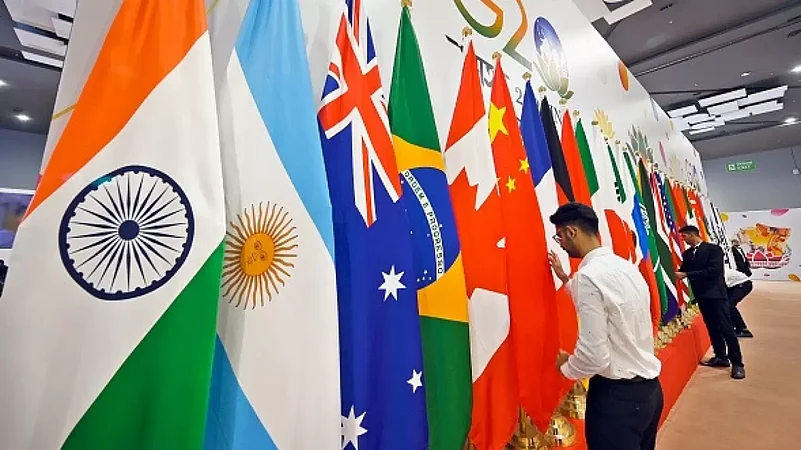There are several theories as to why our capital city is called Delhi. As is often the case in such matters, it is shrouded by a number of myths and legends. One of them suggests that it was named Dhillu after the king who built this city in 50 BCE. Others believe that it came to be known as such because of the coins under the Tomara rule that were known as dehliwal. There are historians who believe that it comes from the Hindustani word Dehlīz which means doorstep.
The theory of Alexander Cunningham, who played a pivotal role in the formation of the Archaeological Survey of India and is known as the father of Indian archaeology, theory seems most plausible. The city under King Prithviraj was known as dilpat dilli and later became dihli/dehli. Panipat and Sonepat, cities near Delhi, still retain the ‘pat’. Dil in Hindustani means heart, soul, or mind. Cunningham mentioned that dilli later became dihli/dehli.
However came the name, what is evident, without a shadow of a doubt, is that this city has seen many an empire rise and fall, many an emperor come and go. Since the earliest recorded history (Tomara dynasty in 8th century), Delhi has been destroyed and rebuilt several times, always emerging stronger than before. One square mile of Purani Delhi (Red Fort, Jama Masjid, Chandni Chowk etc.) alone is a world in itself!
India hosted the G20 Summit in Delhi and hosted it rather magnificently. UN Secretary-General Antonio Guterres praised India’s Presidency of the G20. He remarked: “I’d like to say and I believe I should pay tribute to the Indian Presidency. The Indian Presidency did its best in order to have the South’s voice represented and did its best to put the development agenda in the centre of the discussions.”
The UN Secretary-General, who was in Delhi to attend the G20 Leaders' Summit, further said: “Of course, the conclusions are what they are. They depend on what countries are ready to accept. But I think that effort needs to be underlined.”
What was rather tricky for India was to host two invitee nations at loggerheads at the same time. The US State Department official spokesperson Matthew Miller said: “We absolutely believe it was a success.” The very same day, Russian Foreign Minister Sergey Lavrov praised India not only for its pivotal role in countering Western dominance on numerous fronts but also for not allowing the G20 to “Ukrainise” the meet. In fact, newspapers around Pakistan praised “India for showcasing its growth and achievements to the world and hosting a successful G20 Summit”. What a stamp of approval!
Pakistan’s “irreplaceable, all-weather friend” China was to attend too. However, Chinese President Xi Jinping pulled out last minute. And as is China’s decision-making policy, it was without any explanation. Notably, this was the first time that Xi has ever missed a G20 Summit since becoming the paramount leader of the People’s Republic of China. Russian President Vladimir Putin was courteous —as is the demand of our old ties and strategic partnership— enough to call the Indian Prime Minister and convey that due to his busy schedule, Foreign Minister Sergei Lavrov would be attending on his behalf.
Putin’s absence was completely understandable. Not that India is a signatory of the statute of Rome, but given an active warrant against him issued by the International Criminal Court, it would have made it rather awkward for not only India and Putin but also the heads of state which are parties to the Rome Statute.
Composed of the world’s largest economies, the G20 accounts for 80 per cent of the gross world product (combined gross national product of all the countries in the world), over 65 per cent of the global population, and nearly 75 per cent of international trade. Out of all the G20 nations, India is not particularly friendly with China — to put it mildly. Russia and the United States aren’t best friends either — to put it even more mildly. Neither does the US share great relations with China. Relations between the US and Saudi Arabia saw a fall after the state-sponsored, Crown-sanctioned assassination of Jamal Kashoggi —beyond any reasonable doubt as has now been established— at the Saudi consulate in Istanbul in October of 2018.
Mr Biden criticised the then-Trump administration and promised strict action if elected. Although, as is almost always the case, upon assuming office, Biden’s stance softened. In fact, in this case, it wasn’t just because there is an actual difference between giving a statement to the press rather than taking concrete action upon assuming office, that too, against a country as influential as Saudi Arabia. In fact, followed by the US, Saudi is the largest producer of oil in the world. Post the invasion of Ukraine by Russia, the sanctions contributed to soaring inflation in the US. The unprecedented increase in gas and oil prices meant a decreased popularity for Biden at home. It became Biden’s priority to find an alternative to the Russian energy sources. He tried approaching Venezuela and is also
said to have considered an increased oil flow from Iran. Apparently, he tried talking to both Mohammad Bin Zayed, President of UAE, and Mohammad Bin Salman of Saudi Arabia into increasing the oil exports – both in vain.
Biden decided to visit Saudi Arabia. It has been so far the most difficult call of his presidency in fact. How do you visit an absolute ruler in his country after having issued derogatory statements against him? Without wanting to be seen as going back on his word, President Biden went to Saudi Arabia under the guise of “further integration of Israel in the Arab region”. He was accused of helping rehabilitate the reputation of a murderous prince in exchange for limited gains at home in the US. In Saudi Arabia, he was criticised for not shaking hands with the de facto ruler of Saudi Arabia Mohammad bin Salman. He chose to ‘fist bump’ him instead.
Saudi Arabia has created this façade recently. It has ‘warmed up’ to China immensely and made efforts to make sure that the world notices it too — a reminder perhaps that there are other influential friends in the world who need oil and that the ruler of the Kingdom of Saudi Arabia deserves much more than just a fist-bump. It is highly unlikely that Saudi Arabia will ever abandon its time-tested ally in the United States. The façade is being created to seek attention and for the Biden administration to change its stance and soften the attack on the prince.
“The only constant in life is change,” said Heraclitus. The world order has drastically changed in the recent past. If we take a look at just the past 100 years, what a stark difference we see! The British Empire was at its zenith in 1922. It was the largest empire that the world had ever seen, ruling over a quarter of the Earth. For well over a century, the British Empire was the foremost global power. By 1945, the United States and the Soviet Union emerged as rival ‘superpowers’. The Cold War between the two superpowers lasted some four and a half decades. They both conducted some of the most potent nuclear tests. In fact, it was on October 30, 1961 that the USSR demonstrated to the world what they were capable of. They tested the Tsar bomba. It was the most powerful human-made explosion ever. To put it into perspective, it was 10 times more powerful than all of the ordnance used in the entirety of World War II and it was over 1,500 times more powerful than the combined bombs dropped at Hiroshima and Nagasaki! The seismic wave generated by the explosion circled three times around the globe!
Sī vīs pācem, parā bellum. (If you want peace, prepare for war.) The outcome? The US stopped increasing its thermonuclear power and in 1963 signed the treaty banning nuclear weapon tests. In August of 1991, the Soviet Union fell. The United States was left as the world’s sole superpower. The United States retains that title even today but the balance of power is changing ever so quickly. India and China are emerging and are all set to become major players in less than two decades to come.
The Chinese top brass has had sleepless nights witnessing the cordial relations between India and most of the G20 nations. What in fact is more worrying for China is the fact that Kim Jong Un decided to visit Russia. The dictator’s ornate, armoured train was seen trundling across the North Korean-Russian border last week. Democratic nations around the world kept a close eye and it was 40 hours later that Kim resurfaced in Vostochny. Vostochny Cosmodrome is a space base in far-flung Eastern Russia. Why he travelled to Vostochny was unclear. What is lucid though is that Putin rolled out the red carpet for him, gave him the centre stage and treated him lavishly. In fact, Putin himself travelled to Vostochny to greet and meet Kim.
Kim had been begging and crying for attention. Just before the start of the G20 Summit in New Delhi, North Korea announced that it had launched “a Korean-style tactical nuclear attack submarine to bolster the naval force to further strengthen the state nuclear deterrence both in quality and quantity and by leaps and bounds for regional and global peace and security”. Historically, North Korea is China’s junior ally. So blatant in fact is the comradery that the vehicles from which it conducts these banned missile tests are made in China! In basic terms, having North Korea as a neighbour rather than the American ally South Korea makes Beijing feel safer. Both the North and the South were one country before the Korean War. Today, South Korea’s GDP is 57 times greater than that of the North. North Korea has been a great asset for China. The sort of language that Kim Jong Un has used in the recent past is unheard of in the civilised world. In 2017, he threatened the Trump administration and said that he would “reduce the US to ashes with nuclear weapons if America fires even a single bullet at North Korea”. In 2019, he called Mr Biden (still a candidate for presidency back then) a “rabid dog” that should be “beaten to death”. Reckless for sure. Emboldened? Of course!
Is it a strategic move on Russia’s part to invite and host and display to the world their “muscleman”? North Korea had equally good ties with the Soviet Union and China in its formative years. Since the 1970s, China’s proximity to the Kim dynasty is legendary. The question remains, is Russia poaching a vulnerable Kim in this need of hour or is Kim trying to jump into Putin’s lap in the early stages of the polarisation of the world? Or is it simply time for the world order to change? Only time will tell. What is evidently clear though is that India’s time has now come.
(Sartaj Chaudhary is Master of Laws from the prestigious Kent University. His areas of interest are terrorism, regional conflicts, and international relations. An expert in International Law, he has written extensively about the changing global order and numerous other contemporary issues. He can be reached at chaudharysartaj1@gmail.com. Views expressed are personal.)





















